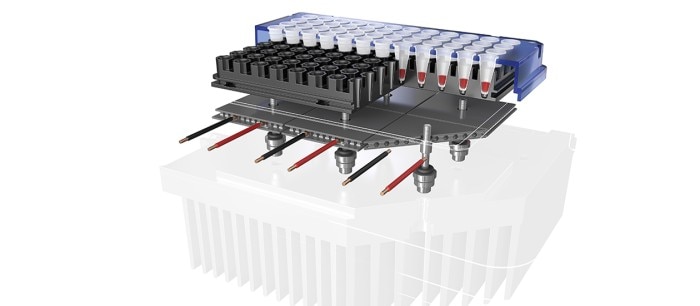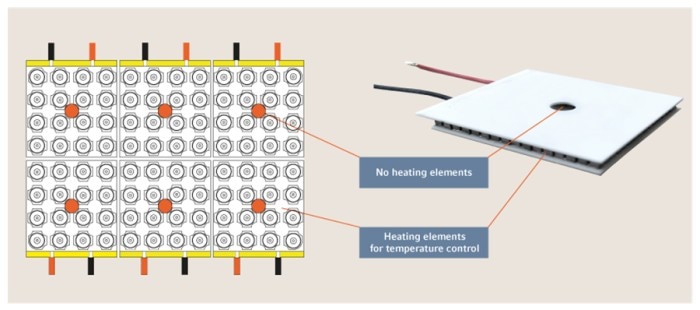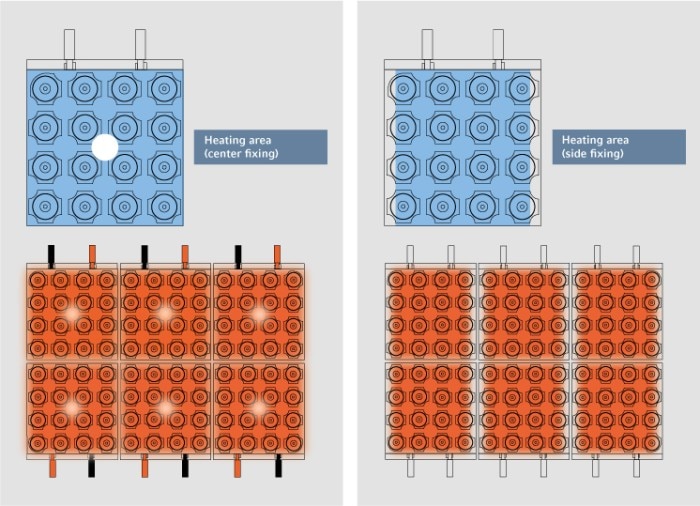MENU
DK | DKK
DK | DKK
No results found
Search Suggestions

Peltiers in PCR Matter!
Lab Academy
- Molecular Biology
- PCR Cyclers
- Efficiency
- Amplification & PCR
- Quality
- Reproducibility
- Essay
Since the introduction of PCR, thermal cyclers are no longer an unfamiliar piece of equipment to molecular biologists. However, because thermal cyclers have increasingly becoming a commodity product, it makes differentiation between different thermal cyclers difficult.
Small differences can be seen from their specifications, such as ramp rates, temperature accuracy and homogeneity, gradient range and even ergonomic features such as noise and easy operation.
However, what these specifications really mean can be difficult to say. Even less obvious are parts of the thermal cycler that cannot directly be seen. Some of these parts are critical for the performance of the thermal cycler and yet are not widely known to the users.
One of these elements is the PCR peltier. Peltiers are the component within a thermal cycler that are responsible for heating and cooling the metal block. The heat from the metal block will then be transferred into the chemical reaction within the plastic vessels. Almost all end-point PCR thermal cyclers in the market currently use peltier technology for heating and cooling.
However, there are differences in the peltiers used. One important criteria is quality. Quality PCR peltiers last longer and will give better temperature performance. Third party assessment such as one done by the Fraunhofer Institute, a leading material research facility in Germany, would provide a more objective reference than peltier manaufacturers’ specifications.
The second critical point of consideration is how the peltiers are assembled in the block. In simplified engineering, a functional thermal block is made up of the metal aluminum/silver block on top, the peltiers in the middle and the heat sink at the bottom. These three parts needed to be fixed together.
An important point to remember is that a PCR peltier is a sandwich of heating elements (Figure 1) and where you have a fixing point, there naturally cannot be any heating element. Hence, if the place where there is an absence of heating elements coincides with the location of the wells in the block above the peltier, there would be no direct heating of that particular well of the block.
However, what these specifications really mean can be difficult to say. Even less obvious are parts of the thermal cycler that cannot directly be seen. Some of these parts are critical for the performance of the thermal cycler and yet are not widely known to the users.
One of these elements is the PCR peltier. Peltiers are the component within a thermal cycler that are responsible for heating and cooling the metal block. The heat from the metal block will then be transferred into the chemical reaction within the plastic vessels. Almost all end-point PCR thermal cyclers in the market currently use peltier technology for heating and cooling.
However, there are differences in the peltiers used. One important criteria is quality. Quality PCR peltiers last longer and will give better temperature performance. Third party assessment such as one done by the Fraunhofer Institute, a leading material research facility in Germany, would provide a more objective reference than peltier manaufacturers’ specifications.
The second critical point of consideration is how the peltiers are assembled in the block. In simplified engineering, a functional thermal block is made up of the metal aluminum/silver block on top, the peltiers in the middle and the heat sink at the bottom. These three parts needed to be fixed together.
An important point to remember is that a PCR peltier is a sandwich of heating elements (Figure 1) and where you have a fixing point, there naturally cannot be any heating element. Hence, if the place where there is an absence of heating elements coincides with the location of the wells in the block above the peltier, there would be no direct heating of that particular well of the block.
Read more
Read less

Figure 1: The peltier component and its heating elements. The six orange circles represent the fixing points of each peltier.
A direct consequence would be an uneven heating across the different wells in the block, since some wells will have heating elements directly underneath while those wells above the fixing points need to rely on heating from adjacent heating elements. Hence, choosing fixing points of the peltier at the locations where there are no wells for PCR vessels directly above would be the best strategy.
Additionally, the fixation point (with missing heating elements) should ideally be surrounded by heating elements so that heat compensation for the missing area is evenly distributed. This will result in minimal temperature differences between wells, increasing overall temperature homogeneity.
There are two common options to fix the PCR peltier: Center and side fixing (Figure 2). Using a center fixing strategy the heating area is effectively larger than the thermal block because no space was taken up unnecessarily for fixing purpose. In contrast, the space below some peripheral wells are taken up for fixing the peltiers, resulting in “cold areas”. The amount of heating energy in wells above those areas is thus lower, leading to what can be called an “edge-effect”, where wells at the periphery of the block have a different performance than those in the middle.
Additionally, the fixation point (with missing heating elements) should ideally be surrounded by heating elements so that heat compensation for the missing area is evenly distributed. This will result in minimal temperature differences between wells, increasing overall temperature homogeneity.
There are two common options to fix the PCR peltier: Center and side fixing (Figure 2). Using a center fixing strategy the heating area is effectively larger than the thermal block because no space was taken up unnecessarily for fixing purpose. In contrast, the space below some peripheral wells are taken up for fixing the peltiers, resulting in “cold areas”. The amount of heating energy in wells above those areas is thus lower, leading to what can be called an “edge-effect”, where wells at the periphery of the block have a different performance than those in the middle.
Read more
Read less

Figure 2: Heating areas (shaded orange) of the thermal block when fixing peltiers at the center vs. heating areas of the thermal block when fixing peltiers at the sides. Blue shaded areas correspond to the location where heating elements in the peltier are physically present.
The center fixing strategy also has another advantage – it allows a bigger leeway when compensating for the mechanical stress of the peltier when the elements expand and contract during heating and cooling. This reduction in mechanical stress results in a longer lifetime of the thermal block, consequently saving cost for their users in the long run.
In contrast, the side fixing strategy cause higher mechanical stress on the PCR peltier, which would affect the lifetime of the thermal block. The wells not fully covered by peltiers underneath also would not have uniformed heating.
In summary, a center fixing strategy of peltiers would result in an effectively “larger than the block” heating area, thus ensuring the outer wells have the same temperature as those in the center. This results in high temperature homogeneity across the entire block, without edge-effect. Ultimately, this means that one can use the full 96-wells or 384-well plate capacity to get reproducible results, thus ensuring maximum productivity and total cost saving.
Eppendorf thermal cyclers use peltiers from supplier that was first tested and verified by Fraunhofer Institute, then chosen from one of the two best performing peltier sources after vigorous selection. The block design of Eppendorf Mastercyclers X50 uses a center fixing method and six individual circuit control technology for high temperature accuracy and homogeneity.
In contrast, the side fixing strategy cause higher mechanical stress on the PCR peltier, which would affect the lifetime of the thermal block. The wells not fully covered by peltiers underneath also would not have uniformed heating.
In summary, a center fixing strategy of peltiers would result in an effectively “larger than the block” heating area, thus ensuring the outer wells have the same temperature as those in the center. This results in high temperature homogeneity across the entire block, without edge-effect. Ultimately, this means that one can use the full 96-wells or 384-well plate capacity to get reproducible results, thus ensuring maximum productivity and total cost saving.
Eppendorf thermal cyclers use peltiers from supplier that was first tested and verified by Fraunhofer Institute, then chosen from one of the two best performing peltier sources after vigorous selection. The block design of Eppendorf Mastercyclers X50 uses a center fixing method and six individual circuit control technology for high temperature accuracy and homogeneity.
Read more
Read less
